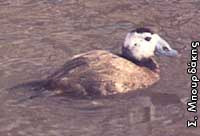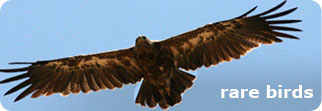 White-headed duck is an unusual duck, easily distinguished by everyone lucky enough to observe it in a wetland. Drake has a large white head, black neck and bluish "swollen bill", while its body is light brown and its spiked stiff tail is often erected, giving it a distinct silhouette.
White-headed duck is an unusual duck, easily distinguished by everyone lucky enough to observe it in a wetland. Drake has a large white head, black neck and bluish "swollen bill", while its body is light brown and its spiked stiff tail is often erected, giving it a distinct silhouette.
Drakes and ducks have the same size, no more than 43-48 cm, but ducks have generally darker head, light-colored cheeks crossed by a dark line, while their body is chestnut-rufous. They are cumbersome at land, but they are very fast in the water, using their odd tail for propulsion.
White-headed Ducks breed in shallow fresh or brackish marshes connected with larger wetland complexes. Such wetlands are often seasonal, created by spring floods and drained at summer, but they are especially productive, being very rich in aquatic vegetation and invertebrates. In winter, White-headed Ducks prefer large brackish or saline lakes.
The ecology of this species is very interesting and peculiar. Its body construction makes it more water-dependant than other duck species. It is, also, one of the few water birds that moult twice a year, during breeding season and winter, being unable to fly during these periods. In winter they form large flocks, but in spring they scatter in small groups in search for suitable breeding sites.
Due to the fact that they prefer to nest in seasonal weather-dependent marshes, White-headed Ducks have been developed so that they breed later than other ducks and they also lay more eggs. Even though their reproductive potential is particularly high (up to 80%), few adult birds breed every year. As a result, overall breeding success is relatively low.
The dependency of White-headed Ducks on irregularly formed seasonal marshes and small shallow wetland is the greatest threat for their survival as those areas are the most vulnerable to drainage and conversion to agricultural land or pastures.
Moreover, interventions to the hydrology of extended wetland complexes by the control of floods, the creation of embankments and dams, irrigation networks, drainages and excessive drillings, have disturbed the hydrological cycle and many seasonal marshes have been disappeared.
White-headed Duck is one of the rarest bird species in the world, with a world population of no more than 15,000 birds. Its present distribution is highly scattered, having two main subpopulations, one in western and the other in eastern Mediterranean, the Black Sea and the Caspian Sea.
The western population is resident, numbering about 1,000 birds breeding mainly in Spain but also in Algeria and Tunisia. The eastern population is larger and migratory. White-headed Ducks breed mainly in Turkey, where the biggest population is located (200-300 pairs), while fewer breed in Russia, Iran and occasionally in Romania.
It’s worth mentioning that in the early 20th century, White-headed Duck’s population was estimated at 100,000 birds, while today has been reduced by 80%. White-headed Ducks were nesting in Italy, Corsica, Morocco, Hungary, Albania, and there are reports for Greece also. From the ‘80s, White-headed Ducks are observed almost every year in small numbers in wetlands of Macedonia and Thrace.
From 1990, however, a drastic increase has been noticed in the number of birds visiting our country, reaching the record number of 2,300 birds in 1997 in Lake Vistonida. Their preference for this particular lake is obvious as almost all of the birds observed in Greece were in this lake, with the exception of very few and solitary individuals in Lake Ismarida and Lake Kerkini. We are still not aware of the reasons for this preference, and we also do not know if these birds come from Turkey or Russia.
With the financing of the Dutch Organization for the protection of birds, the systematic guarding and monitoring of White-headed Duck in Lake Vistonida was launched on October of 1998, which includes cooperation with Turks and Spanish experts.


 White-headed duck is an unusual duck, easily distinguished by everyone lucky enough to observe it in a wetland. Drake has a large white head, black neck and bluish "swollen bill", while its body is light brown and its spiked stiff tail is often erected, giving it a distinct silhouette.
White-headed duck is an unusual duck, easily distinguished by everyone lucky enough to observe it in a wetland. Drake has a large white head, black neck and bluish "swollen bill", while its body is light brown and its spiked stiff tail is often erected, giving it a distinct silhouette.
